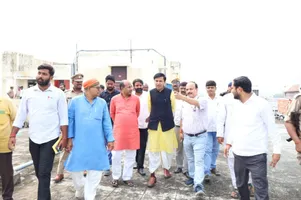Raza Palace of Nafees Demolished by Bulldozers; 40 BDA Workers Utilize Gas Cutters and Hammers
In a dramatic turn of events, the historic Raza Palace of Nafees has been reduced to rubble, as a team of 40 employees from the Bangalore Development Authority (BDA) commenced demolition operations using bulldozers and heavy machinery. This notable structure, which once stood as a testament to architectural elegance, is now a victim of aggressive destruction, leaving many local residents and heritage enthusiasts in shock.
The demolition crew arrived at the site early in the morning, equipped with gas cutters and hammers, ready to dismantle what remained of the once-majestic palace. Eyewitnesses reported that the sound of metal grinding against stone echoed through the area as workers systematically tore down the walls and ceilings, sending debris flying into the air. The scene was chaotic, with dust clouds enveloping the surroundings as the workers proceeded with their task, seemingly unfazed by the historical significance of the building.
The Raza Palace, known for its intricate architecture and rich history, had served as a cultural landmark in the community. Many local citizens expressed their dismay at the rapid destruction of such an important site. Residents gathered nearby, voicing their frustrations and lamenting the loss of a piece of their heritage, with some individuals even attempting to intervene and halt the demolition process. However, their efforts were in vain as the BDA employees continued their work unabated.
The authorities have defended the decision to demolish the palace, citing structural instability and safety concerns as the primary reasons. Officials stated that the building had deteriorated significantly over the years, making it a potential hazard to the surrounding area. Nonetheless, critics argue that there should have been more effort made to preserve the historic site, possibly through restoration or renovation instead of outright demolition.
As the bulldozers continued to level the remains of the Raza Palace, conversations among residents turned to the broader implications of such actions. Many questioned the BDA’s commitment to preserving the city’s cultural heritage, suggesting that this incident reflects a worrying trend of neglect towards historic buildings in the area. The demolition has sparked a heated debate among citizens, historians, and conservationists alike, who are now calling for stricter regulations to protect heritage sites from similar fates.
In the aftermath of the demolition, local advocacy groups are mobilizing to raise awareness about the importance of preserving historical landmarks. They are urging the government to implement policies that prioritize the restoration of significant structures, rather than resorting to demolition. Activists argue that by preserving these buildings, cities can maintain their unique character and cultural identity, which is often lost in the face of urban development.
The destruction of Raza Palace serves as a stark reminder of the ongoing battle between development and preservation in urban landscapes. As cities continue to grow and evolve, the challenge remains to find a balance that honors historical significance while accommodating modern needs. The outcry from the community following this incident emphasizes the need for a collective effort to safeguard cultural heritage for future generations.
As discussions surrounding the Raza Palace continue, it is clear that this incident has ignited a passionate response from the community. Many are now more aware of the fragility of their local heritage and the importance of advocacy in protecting it. The hope is that this tragic event will lead to meaningful change in policy and practice, ensuring that future generations will have the opportunity to appreciate and learn from their historical landmarks.
The fate of Raza Palace may be sealed, but its story is far from over. As citizens rally together to protect their history, the call for preservation resonates louder than ever. It remains to be seen how this incident will shape the future of heritage preservation in the region, but one thing is certain: the community’s voice will not be silenced.
